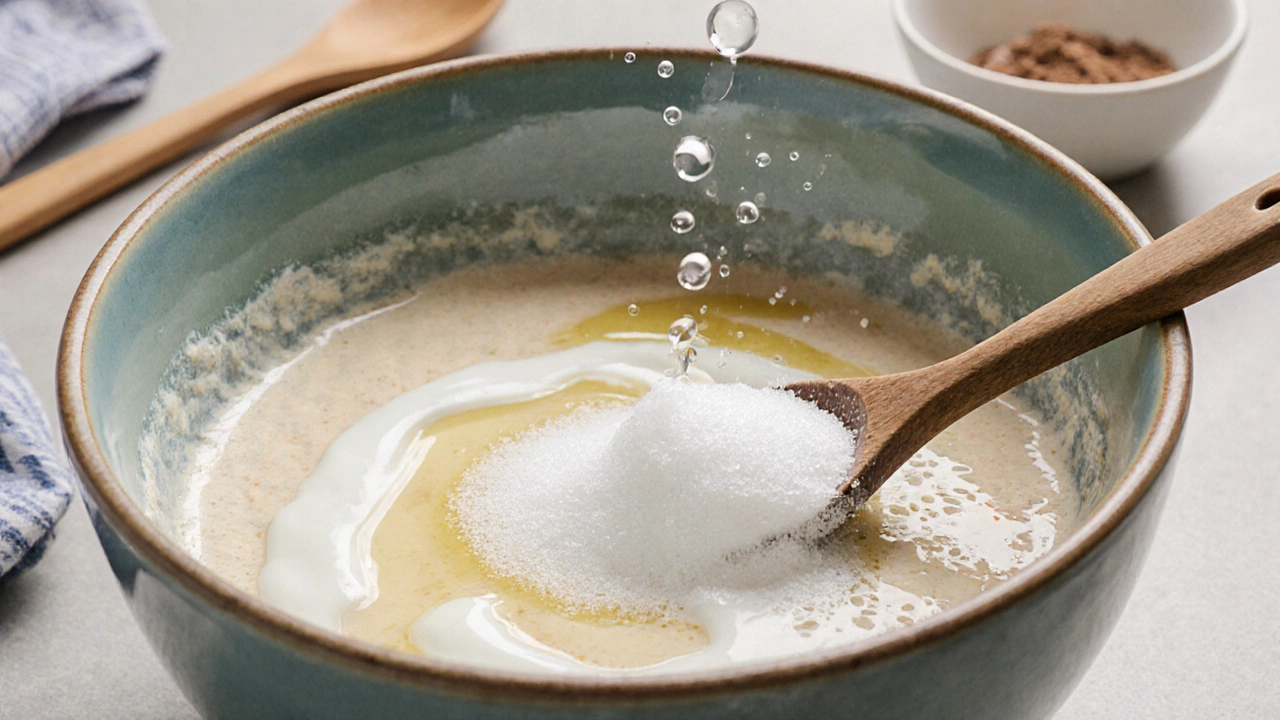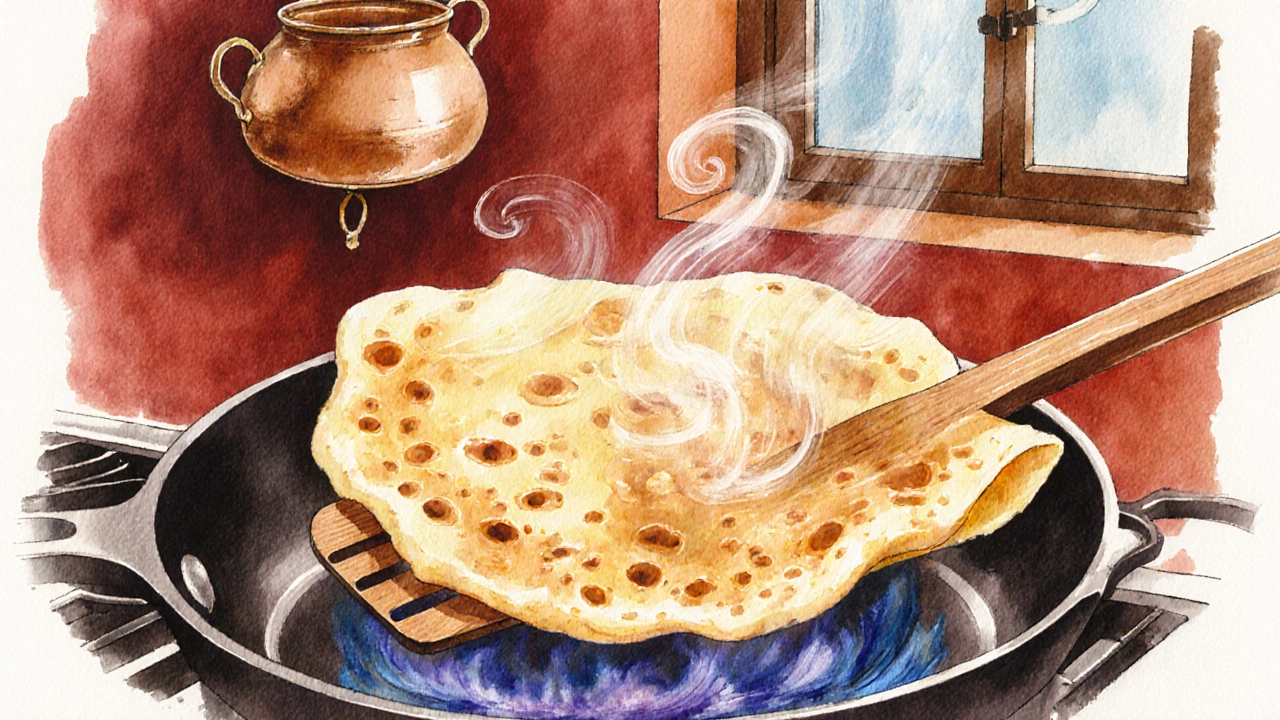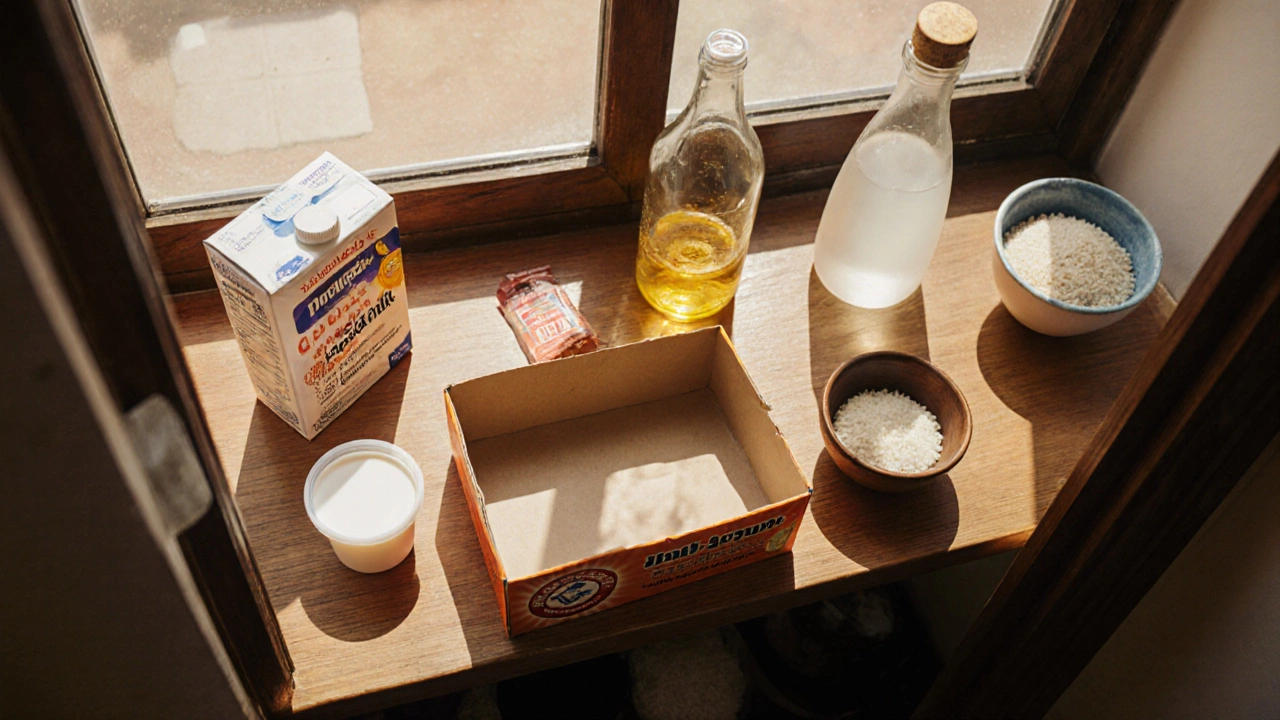Dosa Batter Substitute Calculator
Substitute Calculator
Results
Select batter quantity and substitute type to see results.
Ever cracked open your pantry, only to realize you’re out of baking soda right before a dosa night? The puff‑and‑crisp texture you love comes from a little chemical lift, and without it, the batter can turn flat and dense. Good news: you don’t have to scramble for a store‑bought packet. There are several kitchen staples that can step in, each with its own quirks and flavor twists. Below you’ll find the science, the swaps, and the exact steps to keep your dosas fluffy without a single pinch of baking soda.
Key Takeaways
- Acid‑base reactions are what give dosa batter its airy structure.
- Popular baking soda substitute options include yogurt, buttermilk, lemon juice, vinegar, yeast, and fermented rice.
- Adjust the liquid‑to‑dry ratio when using liquid substitutes to avoid a runny batter.
- Fermentation time can be shortened with some substitutes, but flavor development still benefits from a few hours at room temperature.
- Watch for off‑flavors: too much vinegar or lemon can make the batter taste sour.
Why Baking Soda Matters in Dosa Batter
Traditional South Indian dosa batter is a blend of soaked rice and urad dal that ferments naturally. Over time, the wild lactobacilli produce lactic acid, which lowers pH. When you add a pinch of baking soda (a base), it reacts with the acids to release carbon dioxide - the tiny bubbles that lift the batter during cooking. This reaction is what makes the dosa crisp on the edges yet soft inside.
When you don’t have baking soda, you need two things: an acid source and a way to generate gas. Many pantry items can provide one or both of those components, which is why they work as effective replacements.
Top Substitutes and How They Work
Below is a quick rundown of the most reliable swaps. The first mention of each ingredient includes micro‑data markup so search engines can recognize them as distinct entities.
Yogurt is a fermented dairy product that contains lactic acid and live cultures. When mixed into the batter, its acidity reacts with a small amount of baking soda if you have any left, or simply creates tiny bubbles through natural fermentation.
- Use ¼ cup plain yogurt for every cup of rice‑dal mix.
- Reduce added water by 2‑3 tbsp to keep the batter thick.
- Allow 4‑6hours of fermentation; the yogurt speeds up the process.
Buttermilk is the liquid left after churning butter, rich in lactic acid. Its acidity is slightly stronger than yogurt, so you need a tad less.
- Replace the water with an equal amount of buttermilk.
- Add ¼ tsp of cream of tartar if you want extra lift.
- Ferment for 3‑5hours; the batter will develop a pleasant tang.
Lemon Juice provides 100% citric acid, a strong acid that reacts quickly with any residual alkalinity. Because it’s purely liquid, you’ll need to balance the moisture.
- Mix 1 tbsp lemon juice with 2 tbsp water for each cup of batter.
- Allow 2‑3hours of rest; the batter will puff up without a long ferment.
- Watch for a pronounced sour note - add a pinch of sugar if needed.
Vinegar (white or apple cider) works similarly to lemon juice but has a milder flavor profile.
- Use ½ tbsp vinegar plus 2½ tbsp water per cup of batter.
- Combine with a pinch of baking powder (if you have it) for extra rise.
- Rest for 2‑4hours; the batter should bubble lightly.
Active Dry Yeast is a living organism that ferments sugars, releasing carbon dioxide. Unlike acid‑base swaps, yeast needs sugar and warm temperature to thrive.
- Dissolve ¼ tsp yeast in ¼ cup lukewarm water with a pinch of sugar.
- Let it foam for 5‑10minutes.
- Stir the yeast mixture into the cooled rice‑dal batter.
- Allow 6‑8hours of fermentation; the batter will become airy and slightly yeasty.
Fermented Rice (Idli Rice) is rice that has been soaked and allowed to naturally sour. The natural lactobacilli produce acids that can react with any residual base or simply create bubbles during cooking.
- Soak ½ cup idli rice overnight, then grind with urad dal.
- Add a splash of water to reach batter consistency.
- Ferment for 8‑12hours; the longer the ferment, the lighter the dosa.

Adjusting Quantities: A Simple Formula
When swapping a liquid acid (lemon juice, vinegar, yogurt, buttermilk) for baking soda, aim for a pH around 6-7. A quick rule of thumb:
- For every ½ tsp of baking soda originally called for, use 1tbsp of an acid (lemon juice or vinegar) plus 2tbsp of water.
- If using yogurt or buttermilk, replace the same volume of water; the acidity is already balanced.
- When using yeast, skip additional acids - the yeast will handle the lift.
Always taste the batter after the rest period. It should have a faint tang and a slightly bubbly surface. If it feels too acidic, add a pinch of sugar or a splash of milk to mellow it out.
Tips for Perfect Dosas Without Baking Soda
- Temperature matters. Ferment at room temperature (22‑25°C) for consistent bubbles. In colder climates, use a warm spot like an oven with the light on.
- Don’t over‑mix. After adding the substitute, stir just enough to combine. Over‑mixing can break down the gas bubbles.
- Use a non‑stick iron or cast‑iron skillet. The heat retention helps the batter spread thin and puff up.
- Rest the batter after each addition. If you add more yogurt mid‑way, give it 30minutes to settle.
- Season wisely. A pinch of salt enhances flavor but also strengthens gluten formation, aiding structure.
Comparison of Common Substitutes
| Substitute | Acid Strength | Liquid? | Fermentation Time Needed | Flavor Impact |
|---|---|---|---|---|
| Yogurt | Medium | Yes | 4‑6hrs | Mild tang, creamy |
| Buttermilk | Medium‑High | Yes | 3‑5hrs | Light sour, buttery |
| Lemon Juice | High | Yes (diluted) | 2‑3hrs | Bright citrus |
| Vinegar | High | Yes (diluted) | 2‑4hrs | Subtle vinegar note |
| Active Dry Yeast | Low (biological) | No | 6‑8hrs | Lightly fermented |
| Fermented Rice (Idli Rice) | Variable (natural) | No | 8‑12hrs | Traditional sour |

Common Pitfalls & How to Fix Them
- Too sour. Cut back on acid or add a pinch of sugar; you can also blend in a splash of milk.
- Batter too runny. Add a bit more rice flour or urad dal flour; remember each liquid substitute adds moisture.
- No bubbles after resting. Check room temperature; if it’s cold, place the batter near a warm stove or inside a turned‑off oven.
- Off‑flavor from too much vinegar. Use half the amount and balance with yogurt or a dash of honey.
Quick Reference Cheat Sheet
- Identify what you have: yogurt, buttermilk, lemon, vinegar, yeast, or fermented rice.
- Follow the quantity guide above.
- Adjust water to keep batter ~2mm thick on the pan.
- Rest for the minimum time listed; longer rest = better flavor.
- Cook on a hot, well‑greased skillet; spread thin, wait for bubbles, flip if desired.
Frequently Asked Questions
Can I use both baking soda and a substitute together?
Yes. Mixing a small pinch of baking soda with an acidic substitute (like yogurt) can give you extra lift while preserving the traditional tang. Just keep the total acid‑base ratio balanced - about ½ tsp soda per cup of batter with 1 tbsp of acid.
Is there a non‑dairy option for vegans?
Turn to lemon juice, vinegar, or a fermented rice base. All are plant‑based and provide the needed acidity. Pair with a bit of cream of tartar if you want extra rise without dairy.
How long can I store batter made with these substitutes?
Refrigerate the batter in an airtight container for up to 24hours. The acidity will keep it safe, but the lift will diminish after a day, so plan to cook within that window for best texture.
Will using yeast change the flavor of my dosa?
Yeast adds a subtle fermented note, somewhat similar to a light sourdough. If you prefer the classic sour‑tang, stick with yogurt or lemon juice. Yeast is great for a fluffy, slightly airy dosa without the sour punch.
Do I need to add extra salt when using these substitutes?
A pinch of salt (about ½ tsp per cup of batter) is recommended regardless of the substitute. Salt enhances flavor and helps the gluten network, giving the dosa a better structure.
